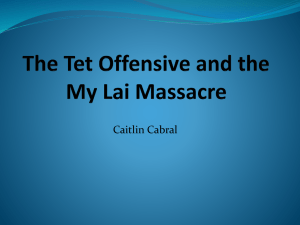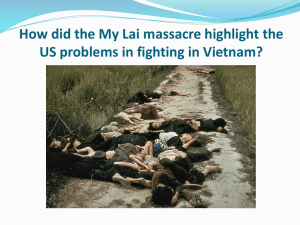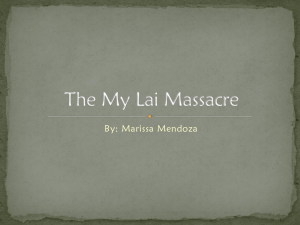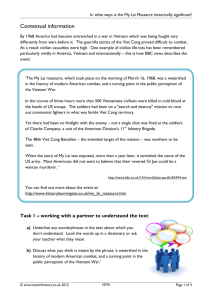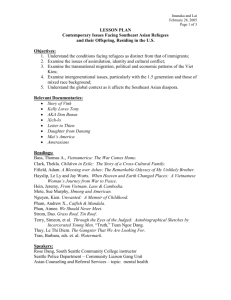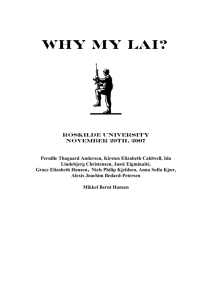Article: Truthout.org Forty Years Later Calley Speaks
advertisement
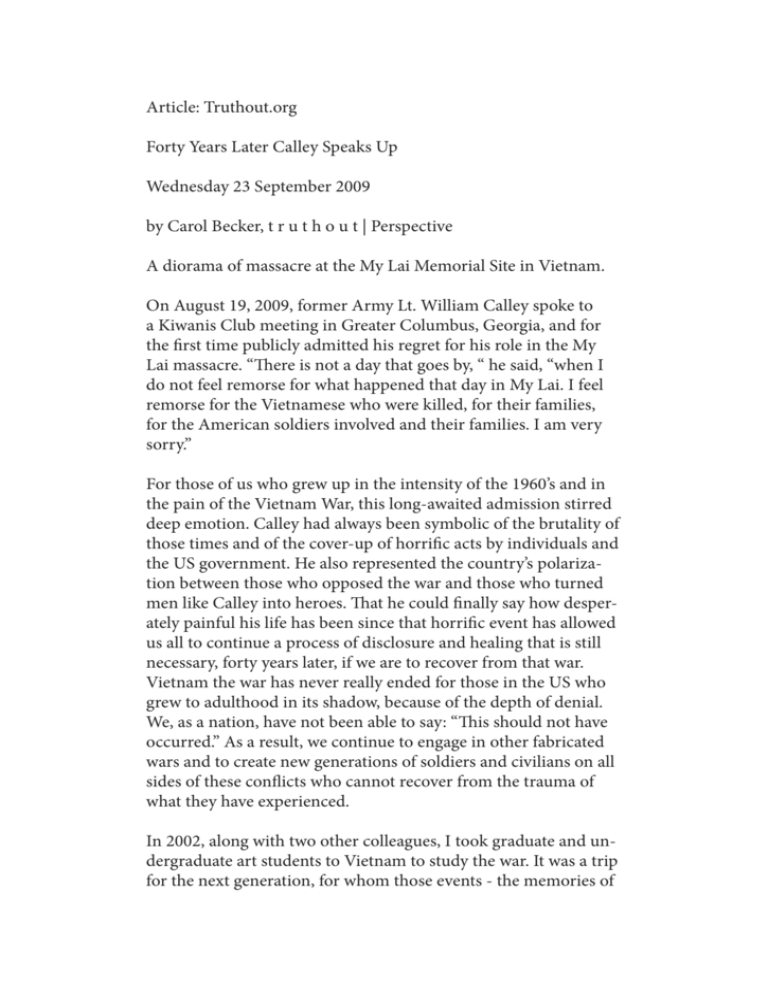
Article: Truthout.org Forty Years Later Calley Speaks Up Wednesday 23 September 2009 by Carol Becker, t r u t h o u t | Perspective A diorama of massacre at the My Lai Memorial Site in Vietnam. On August 19, 2009, former Army Lt. William Calley spoke to a Kiwanis Club meeting in Greater Columbus, Georgia, and for the first time publicly admitted his regret for his role in the My Lai massacre. “There is not a day that goes by, “ he said, “when I do not feel remorse for what happened that day in My Lai. I feel remorse for the Vietnamese who were killed, for their families, for the American soldiers involved and their families. I am very sorry.” For those of us who grew up in the intensity of the 1960’s and in the pain of the Vietnam War, this long-awaited admission stirred deep emotion. Calley had always been symbolic of the brutality of those times and of the cover-up of horrific acts by individuals and the US government. He also represented the country’s polarization between those who opposed the war and those who turned men like Calley into heroes. That he could finally say how desperately painful his life has been since that horrific event has allowed us all to continue a process of disclosure and healing that is still necessary, forty years later, if we are to recover from that war. Vietnam the war has never really ended for those in the US who grew to adulthood in its shadow, because of the depth of denial. We, as a nation, have not been able to say: “This should not have occurred.” As a result, we continue to engage in other fabricated wars and to create new generations of soldiers and civilians on all sides of these conflicts who cannot recover from the trauma of what they have experienced. In 2002, along with two other colleagues, I took graduate and undergraduate art students to Vietnam to study the war. It was a trip for the next generation, for whom those events - the memories of their parents and the US - were not known to them at all. This is an abbreviated retelling of that journey. On March 16, 1968, the men of the 11th Brigade entered the village of My Lai, which they called Pinkville, and brutally murdered 504 Vietnamese civilians. This “search and destroy” mission (Gen. William Westmoreland’s strategy of “flushing out” the Vietcong from their countryside “safe havens”) soon transformed into a bloody massacre: “The killings took place, part maniacally, part methodically, over a period of about four hours,” write Michael Bilton and Kevin Sim in “Four Hours in My Lai,” their chilling account of what happened on that day.1 Several women were gang-raped and killed with unconscionable brutality. Infants were blasted with machine-gun fire. The troops, whose average age was just twenty, were known as Charlie Company. They were under the leadership of Lt. William Calley - a name that became synonymous with the nightmare of the war. He took his orders from Capt. Ernest Medina, who received his commands from even higher up. Those names still have not been spoken. Lieutenant Calley was said to have forced a group of 100 to 170 villagers into a ditch and, without hesitation, slaughtered them all himself. Because of the nature of the war and the US Army’s philosophy of killing “Vietcong in such large numbers that they could not be replaced,”2 because of the pressure on unit commanders to produce enemy corpses, because it was so difficult for US soldiers to “see the enemy” waging this guerrilla war, and because US soldiers were being blown up constantly by land mines planted by this unseen enemy, “it is not surprising that some men acquired a contempt for human life and a predilection for taking it,” observe Bilton and Sim. “In this sense,” they continue, “My Lai was not an aberration of the war, but its apotheosis.”3 This event was one of the turning points in US citizens’ perceptions of the extreme brutality of the war. American soldiers had entered an unarmed village firing, killing everyone and everything alive: women, old men, children, babies and animals. They then torched each house and all the vegetation surrounding the village. Even though it was clear within minutes of the attack that there were no Vietcong in the village, that no one was armed and no one was returning fire, US soldiers, having been told it was a Vietcong stronghold and that they were “to destroy everything in sight,” did not desist from that directive. In fact, it was only because soldiers had been bragging about what had occurred in My Lai for almost a year, that GI Ron Ridenhour, twenty-one years old, even heard about the massacre. He wrote letters to congressmen telling them that something awful and “bloody” had occurred. As a result of his insistence, a serious investigation took place. American Army photographer Ronald Haeberle, who documented the massacre, was also key to this investigation. His photographs were used to substantiate the claim that only civilians had been murdered and in the most brutal ways. The American people did not know about the massacre at My Lai when it actually occurred. A year and a half later, discharged GIs who refused to let the story go brought it to the attention of the military, as well as to writers and journalists. In November 1969, Seymour H. Hersh wrote a piece called “Hamlet Attack Called ‘Point-Blank Murder’” in which he quoted a sergeant interviewed who said, “A few days before the mission, the men’s general contempt for Vietnamese civilians intensified when some GIs walked into a landmine, injuring nearly 20 and killing at least one member of the company.”4 There is no doubt that once the horror of My Lai was understood outside the military, it changed the course of the war. After my first visit to Vietnam in 1996, I knew I would return with students. I did return in January 2002, with other faculty members - filmmaker Jeffrey Skoller and art historian Stanley Murashige - and ten students. We organized many expeditions during this trip together, but perhaps the most significant to many of us was the journey to My Lai. We came to call it a pilgrimage. The students who accompanied us were a mixture of undergraduate and graduate. Most, in their twenties, were not even born when the war was taking place, yet each of them felt drawn to Vietnam and wanted to move from thinking of Vietnam as a war to understanding it as a country. They were adventurers. Some had already traveled to distant places, others had never left the US None had been to Southeast Asia. Joining us as our research assistant was Vu Thu, a young Vietnamese artist I had met on my first visit to Hanoi. By traveling with us, she was choosing to encounter Vietnam through the eyes of Americans, some still filled with guilt for themselves and their country. Although many Vietnamese do not want to dwell on the past, many Americans of my generation still suffer the pain of what happened during the war. When I told a Vietnamese woman in a shop in Hoi An that we had visited My Lai, she said, “Don’t feel bad about what you saw. We know it was your government and not you.” Our goal was to visit many of the places whose names became well-known to Americans during the war. We wanted to experience those places now - to connect with what remains of the past in the present and to gain an understanding of what happened at those sites. In this spirit we visited Hanoi and Ho Chi Minh City. We boated down the Mekong River. We stopped at the DMZ (Demilitarized Zone) and drove to Khe Sahn and the coast of China Beach. We passed through Danang. We stayed in Hue. And of course we made a pilgrimage to My Lai, known to the Vietnamese now as Son My (pronounced shun me). What did we find at My Lai? Everything and nothing. Nothing, of course, remains of the village. There are now only headstones where houses once stood. Engraved into each are the names of those who died. The engraving might say, “Foundation of Mr. Phon Cong’s house burnt by US Soldiers, four of his family members were murdered. Phan Hong 65, Le Thi Duoc 36, Phan San 12, Phan Thi Tranh 6.” “Foundation of Mr. Nguyen Cai’s house burnt by US soldiers. Three of his family members were murdered: Phung Thi Hiep 31, Nguyen Thi Hwe 12, Nguyen Thi Be 3.” These were the people in the village when the Americans arrived - mothers, children, grandparents. At each stone where there was once a house, there is now a place to burn incense for the dead, provided for us at the entrance to the site. There is also the ditch, now overgrown with plants, but still unmistakable as the site into which between 100 and 170 people were pushed, then shot. Jas- mine and hibiscus have overgrown this site, which is now as green and resplendent as the rest of the Vietnamese countryside. There is one stucco structure, and in this building are large blackand-white and color photographs, very specific, about the massacre. After looking at several and reading the captions that appear next to them in Vietnamese and English, one realizes that for these photos to exist at all, someone had to be watching the massacre while it was occurring and, more astoundingly, documenting it. Then you read the text: The photographer taking the pictures was Ronald Haeberle, the official US Army photographer assigned to that platoon on that day. The images taken for the Army and those he took with his own camera for himself became important evidence in the investigation to prove that a massacre had actually occurred. After the war, a set of prints was given to the Vietnamese government. They comprise a great deal of the material in the memorial museum. The documentation allows visitors to walk through the massacre moment by moment - people being rounded up, terror on their faces. Children crying, clutching at their mothers. Very old, bony men walking toward the camera with their arms in the air in gestures of surrender. Piles of bodies in the ditch, one thrown over the other randomly, reminiscent of the mounds of human remains found at Bergen-Belsen after the camps were liberated in 1945. Taking up an entire wall is a list of all those who died: 504 names with ages. The long list is reminiscent of Maya Lin’s wall of the dead, which is categorized by date. The Vietnamese have organized those killed during the massacre in family clusters: The oldest in each family is listed first. The children are always last. This wall became the focal point for a performance created by two students on our return. We did not go to My Lai to judge. The verdict on that event was determined long ago. As Hannah Arendt said, in an interview given to Günter Grass in 1964, in reference to the death camps in Germany: “This ought not to have happened. Something happened there, to which we cannot reconcile ourselves. None of us ever can.”5 My Lai, once a village, now a memorial, was determined to have been the site of a massacre by 1970. Lieutenant Calley was sentenced to life in prison, but this sentence was soon commuted and he actually only served four and a half years in a very well-protected and comfortable prison. He used to run his father-in-law’s jewelry shop in Columbus, Georgia, where he drove a Mercedes-Benz given to him by a supporter and hid from reporters and others asking about the war. Among less-fortunate Vietnam veterans there have been many suicides, murders and men incapacitated for civilian life whose tragic situations are traced to their involvement in My Lai. “The massacre had become a matter for individual conscience alone,” write Bilton and Sim 6 Those who set the policies and gave the orders, and the country that engaged in this war, have retained their psychic freedom, while those who followed the orders laid out by others, and were thus driven to horrific acts, live under a weight of guilt they cannot abide. Some of these individuals continue to suffer for their actions every day and will do so for the rest of their lives. By journeying to such a place as My Lai, it was our hope to develop our own form of absolution. Bilton and Sim write, “National Consciousness consists of what is allowed to be forgotten as much as by what is remembered.”7 The philosopher Giorgio Agamben writes: “Human beings are human in so far as they bear witness to the inhuman.”8 Although Lieutenant Calley, considered a hero by some, waited forty years to speak, his admission of pain and guilt should not be forgotten. As other soldiers return from Iraq and Afghanistan decimated in body and spirit, we are reminded once again that too many soldiers are thrown into too much horror at too young an age, to ever recover from what they have lost, seen, and done. This damage affecting many generations can only stop when we as a nation finally understand what war does. Ultimately all are victims caught in its unsustainable inhumanity. Notes 1 Michael Bilton and Kevin Sim, “Four Hours in My Lai” (New York: Penguin Books, 1992), 3. 2 Ibid., 32. 3 Ibid., 14. 4 Seymour M. Hersh, “Hamlet Attack Called Point-Blank Murder,” in “Reporting Vietnam,” vol. 2 (New York: Library of America, 1998), 19. 5 Giorgio Agamben, “Remnants of Auschwitz: The Witness and the Archive.” Trans. Danielle Heller-Rouzen (New York: Zone Books, 1999), 71. 6 Bilton And Sim, 36. 7 Ibid. 4. 8 Agamben, 12l. copyright, Carol Becker © 2011
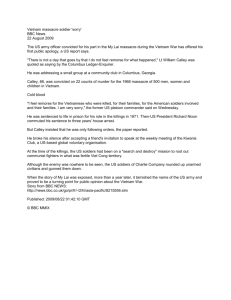

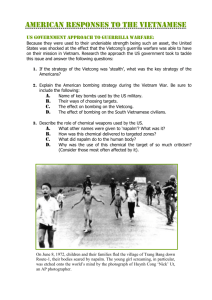
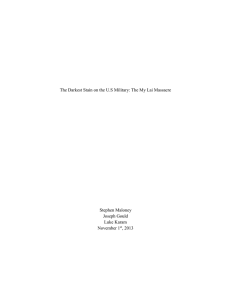
![vietnam[1].](http://s2.studylib.net/store/data/005329784_1-42b2e9fc4f7c73463c31fd4de82c4fa3-300x300.png)
